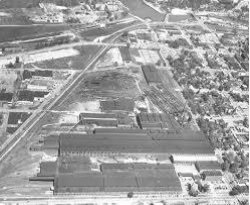Mansion: (3D Satellite, 342 photos)
Midcontinent sites two different corporate histories but they agree that it started in 1852 with Sherman and Haskell as two of the founders. All the sources that I've seen agreed that John Barker bought into the company in 1855. Pullman bought it in 1922 because it wanted to expand its freight car business and H&B was the nation's largest. The PS-1 boxcar was introduced in 1947 and "in 1957 the 109 acre Michigan City plant was claimed to be the largest freight car building plant in the world, capable of producing a freight car every ten minutes." Pullman closed it in 1971.
 |
| safe_image for Barker Mansion debuts exhibit about freight car factory that was once Indiana's largest employer Because of a fire, they rebuilt with the first production line in the United States long before Ford built his first assembly line. "As far as national importance, it was one of the biggest boxcar factories in the country. That's why Pullman bought it in 1916. The factory went from producing a few boxcars a month to 15,000 boxcars a year after it installed its production line." The mansion was built in 1857. |
It was in the northwest quadrant of 8th and Wabash Streets.
 |
| 1953 Michigan City West Quad @ 24,000 |
 |
| BarkerMansion By 1907, the plant was the most complete factory making freight cars in the United States and employed more than any other manufacturing establishment in Indiana. At the time, it sprawled over 100 acres and had 3500 employees who turned out 15,000 cars a year. [This includes a list of some of the cars that have been preserved.] |
 |
| MyMichigan City, Indiana posted At one point, the Haskell & Barker Car Company was the largest manufacturing plant in the state. Chilo Vara: Also visit the Barker Mansion when you get a chance to.... Very beautiful |
 |
| Monon, one of many photos on this site "The factory is credited with being the birthplace of the first modern assembly line, a first often credited to Henry Ford. It also produced an all-steel box car called the PS-1 that was the first standardized box car in American railroading. But by the late 1960s production had shifted elsewhere, and when the company announced on Dec. 18, 1970, that the factory was closing only 70 were working, more than 1,000 workers already having been laid off. Courtesy of Michigan City News Dispatch" This site also describes the 1973 fire that destroyed the place. [I'm reminded that Michigan City was the original destination for the Monon Railroad because, when it was built, water transportation was still important. The Monon was envisioned as a bridge between the Ohio River and the Great Lakes. But quickly the "branch" from Monon to Chicago was added.] |
The company recovered from other fires in 1913 and 1880. I presume the 1913 fire was the one that precipitated the rebuild that used the first assembly line in the United States.
 |
| Steve Shook Flickr, License: Creative Commons Attribution (CC BY) Haskell & Barker Car Company Fire, July 12, 1913 - Michigan City, Indiana [Follow the link to an extensive description of the 1913 fire.] |
 |
| IroquoisTheater The article is about John Barker's nephew escaping from a fire in the Iroquois Theater. |
 |
| mnhs, 1 of 18 photos about the restoration of this 1879 wooden boxcar |
The Illinois Railway Museum has preserved a H&B 1913 wooden side dump gondola.
 |
| IRM "C&WI 1185 is the only piece of equipment at IRM built by the Haskell & Barker Car Company of Michigan City, IN. Haskell & Barker, or H&B, had its origins in the 1850s and from its earliest days specialized in constructing railroad freight cars. By the early 1900s, it was building more than 10,000 cars per year and was one of the largest railroad car building companies in the United States. Following the 1910 death of John Barker, the son of the company’s founder, H&B was sold to an investment company. Then, in 1922, the Pullman Company, which was another prolific builder of freight cars and was most famous for its passenger cars, purchased H&B. The 116-acre H&B manufacturing facility became the Pullman Michigan City plant, said to be the largest freight car manufacturing plant in the world. The plant remained in operation until 1971, when it closed for good." |
.jpg) |
| IRM-photo-gallery, Robert Kutella (trolleycar68), 1 of 6 photos Description: Side panels |
The first of many other freight cars included in this presentation.
 |
| RPMconference |
 |
| Sam Carlson posted The sun came out as we were leaving, and then came the 158 and the C-200. C-200 was built in 1950 and it was long reported in some circles as being the first wide vision caboose ever. (It wasn't) [This photo was taken from the footbridge in the DM&N Proctor Railyard.] David Schauer: What was the first? International Car said this was the prototype in 1952. |
"This is a very fine collection in that it deviates from the standard practice of recording finished cars and concentrates on the daily operation of the building plant." [This source has a superset of the history that is in BarkerMansion]
The catalogue of photos. The first 150 pages are of cars. But then it gets into the manufacturing activity.
For future reference: a history of the Pullman Company

No comments:
Post a Comment